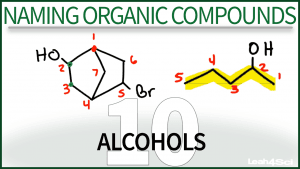 Naming Organic Compounds Series: Video 10
Naming Organic Compounds Series: Video 10
This naming alcohols tutorial video takes you through the steps of naming an organic compound containing a hydroxyl or ‘OH' functional group. Examples include simple and substituted alcohols, saturated and cyclic alcohols.
(Watch on YouTube: Alcohols. Click CC on bottom right for transcript.)
<– Watch Previous Video: Naming Alkyl Halides
–> Watch Next Video: Naming Thiols
This is Video 10 in the Naming Organic Compounds Video Series. Click HERE for the entire series.
Need a review on Functional Groups? Watch the Functional Groups Video, Download the Cheat Sheet, then try the Quiz.
Looking for more in-depth videos on Alcohols? Check out the new Alcohol Video Series!


